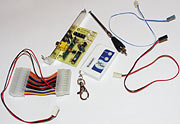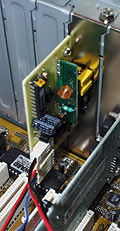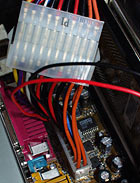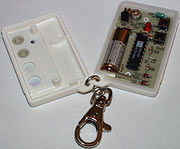
Just Cooler Computer Remote Control
Review date: 9 February 2001.Last modified 03-Dec-2011.
OK, so you're the server admin at a LAN party, right?
The v3.24 update of the dedicated server executable for the UltraGame of the moment includes the new Gooey Burny Stuff With The Screaming And The Blistered Flesh And The Hey Hey Hey It Hurts Me Gun, so everybody insists on playing that version instead of v3.22b.
But the new version's flaky and falls on its face whenever someone jumps through that wall that shouldn't be jump-throughable, on the castle level. Hard lockup, no less. Very uncivilised.
Someone does the wrong thing, the server hangs, O the embarrassment. You will have to hoist your studly rear from your big-screened game machine and lurch over to the scungy server box, to prod Ye Olde Reset Button and bring back the fun.
But you don't.
You merely produce what looks like a car alarm remote control from your pocket and press a button.
And the server goes "beep".
Fade to credits, as your awe-inspiring technical moxie leaves you fighting off prospective sexual partners with nothing but the springy arm of your Mouse Bungee.
What we're talking about, here, is Just Cooler's Computer Remote Control. It lets you control your computer's power and reset functions from some distance, with a keyring UHF radio transmitter.
For most people, it's a nifty but almost totally useless toy. For some people, it could be rather handy.
How it works
A PC draws quite a lot of watts. Even quite modest machines can draw easily a hundred watts on power-up, and stacked machines can need a lot more. If you want to electronically switch that kind of power, you need a relay - a solenoid-activated switch. Of exactly the sort that is not provided on the Just Cooler receiver board. The receiver shown on the box has a couple of relays, but the thing that comes out of the box just has little transistors, without the high voltage and/or current handling you need for high power switching.
Fortunately, the remote system doesn't have to switch any power to speak of. Which is no doubt why they ditched the relays.
Modern ATX computers handle the power switch function without needing big chunky switches, because they already have a relay, built into the power supply.
Reset switches have always been just a couple of motherboard traces that need to be shorted together. Connect any kind of switch, including a remotely controlled one, to the reset-switch pins on the motherboard and you can reset the machine. If you twist one strand of fine copper wire around the bottom of the reset pins, the computer's owner will go bananas trying to figure out why it won't start up.
Or so I'm told.
For this low-power switching, you can use a knife switch or a pressure pad or a glass-break detector, if you like. Or a coin touched to the appropriate pins. Anything. And ATX machines let you control the on/off function in exactly the same way, thanks to the Power Supply Unit (PSU) relay. The power switch just has two more pins on the motherboard case connector header, that's all.
As far as the computer's concerned, any switching system will work just like the normal buttons on the case.
Many ATX Power Supply Units (PSUs) have a normal hardware power switch on the back, but you leave the switch on even when the computer's off. Then, the PSU supplies five volt, low current backup power to the motherboard to allow it to do snazzy things like wake-on-spacebar and wake-on-ring and wake-on-LAN - and to maintain its CMOS memory contents without draining its backup battery.
Setting up
For $AU81.40, the remote control kit gives you a transmitter, a receiver board to mount in the computer, an antenna that connects to the receiver board with an ordinary RCA plug and socket, a power tap dingus and a couple of two-wire cables.
The receiver unit screws into a rear expansion slot hole in your PC case, but nothing plugs into a slot on the motherboard. So you can install it in any spare slot you like.
The receiver's powered by an ATX PSU plug passthrough connector, that taps the purple standby power wire from the PSU. If your PSU's turned off with its back-of-case switch, the remote control won't work; if the hardware switch is on and the PSU's got power, though, the receiver's on all of the time.
There are two other two-wire leads, for the power and reset connectors; you just unplug the connectors from the case switches and plug in the ones from the remote instead. It's all very straightforward.
Which is just as well, because there are no instructions provided. The text on the outside of the box - "...It serves as a friendly user to those who could'nt [sic] get the hang of pushing the POWER/RESET buttons of their PC" - I think qualifies more as a personal insult than as directions for use.
The antenna's a simple telescopic unit, and you can install it pointing in whatever direction's convenient.
Once it's set up and running, it works just like the case buttons. If you've got a system that understands soft-off messages properly, a single press on the power button should shut it down elegantly. If not, there's nothing stopping you using the standard ATX hold-the-button-for-six-seconds method to settle the matter.
Range
The quoted range for the remote's 20 metres, which is a quite respectable distance. But you may get more, or less. It depends on the position of the computer and antenna, the number and composition of walls in the way, and maybe on the ambient RF noise as well. From my wandering-around tests, if you've only got one fairly insubstantial wall between you and the computer, 25 metre range seems perfectly plausible. Your mileage may vary.
Fiddling with the antenna, or knocking together a larger one, ought to give you better range. You could probably also hook it up to a coaxial extension cable and dangle it out of a window or something if you liked. There are tuning issues when you do these sorts of things, but for simple remote controls like this you can get away with some technically awful antenna designs.
Giblets
The remote control...
...is held together by a couple of little screws, and powered by a standard 12 volt alkaline battery, such as runs various car alarm transmitters. It's good for about a year of use.
Just Cooler haven't dropped a blob of epoxy on the board or ground off the markings, so it's easy to see what hardware they're using. It's basic consumer stuff.
Oatley Electronics here in Australia have a UHF remote control kit that uses the same SamHop Microelectronics (or, as the SamHop site has it, "SamHop Mircroelectronics") SM5023RF chip as the Just Cooler gadget. It's on their page of such things, here. The Oatley model has with a suspiciously similar remote transmitter, which can be had by itself as a kit for $AU18, but which has four buttons - the chip supports four channels. You could use a four-button transmitter and a couple of receivers (maybe $AU30 each, for ones with relay switching and not just dinky transistors) to have power and reset control over two computers.
Various other electronics kit places sell gear using this sort of hardware, and you can also get built-up ready-to-go remote switch setups that'd work fine for computers. I don't know if anybody else makes one that doesn't have relays on it, though; logic-level switching's all you need for computer purposes. Relays work fine for ATX computer switching, but they're not necessary; you don't need that much current handling capability.
Cheap remote control systems like this aren't good for car alarms or other situations where security matters. They're wireless doorbell chips, basically.
You can use them for more important applications, but anyone with a UHF "learning remote" can lurk nearby and learn your transmitter's code; these basic systems don't use "code-hopping" to make elementary transmitter duplication impossible.
You can now get code-hopping remote control kits as well, of course; Oatley has one. For low-security PC-rebooting, such security is unlikely to be necessary. Each of the Just Cooler transmit/receive pairs is set up with a different code, at least; that'll do for most purposes.
Why bother?
OK, so what's the use of this thing?
Well, it's obviously handy for some people, who've got a PC they want to power-cycle or reboot, in some inaccessible place. The top of a rack, buried in a cupboard, locked up in the server room.
The idea of lock-up server rooms is, of course, that people outside not be able to clown around with the hardware. But if you find yourself regularly having to press buttons on one of the machines sitting in there, and you don't mind sacrificing some security, the ability to do the deed without budging from your desk down the hall could be rather handy.
The remote control's also got some security functionality. When your power and reset switches are plugged into it, not into the hard switches on the outside of the case, wandering turkeys at a computer show (say) won't be able to stab one button and toast whatever you're trying to demonstrate.
And, for pure wank value, it's hard to beat a computer that powers up automatically as your car pulls into the parking lot and you nonchalantly poke the button.
There's nothing super-special about the Computer Remote Control. There are lots of ways for anybody with a small amount of electronics-hobbyist acumen to achieve the same thing. A couple of lengths of figure-8 speaker cable with toggle switches on the end will do, in a pinch. You could easily enhance the Just Cooler gizmo, too; it would, for instance, be easy enough to knock together a couple of Y-adapters so you could have remote and local switching.
If you want a plug-and-go remote switching solution that's made to fit inside your PC, though, here it is. The price isn't silly compared with other remote-switch gadgets, installation's easy enough and it performs as advertised.
Buy stuff!
Aus PC Market don't sell this
product any more, but you can still try a price search at
DealTime!







